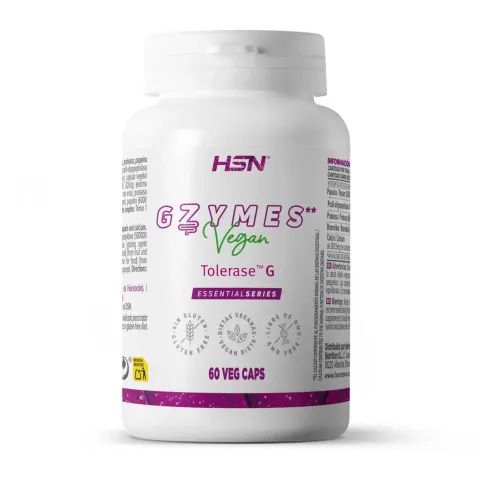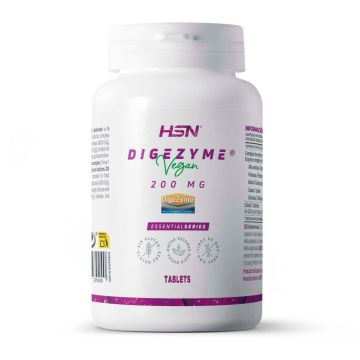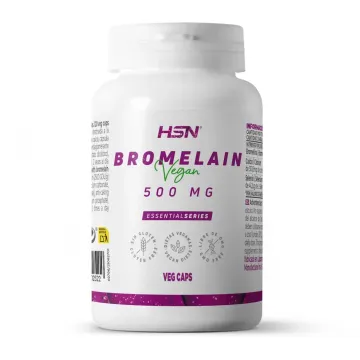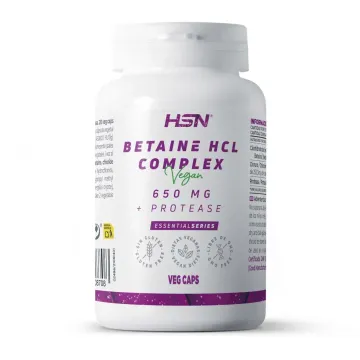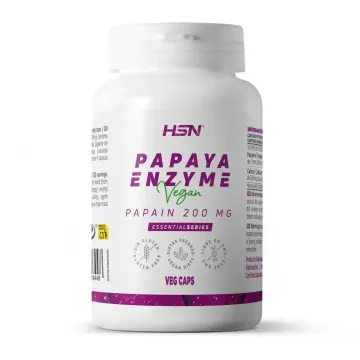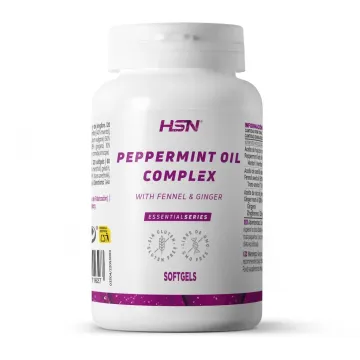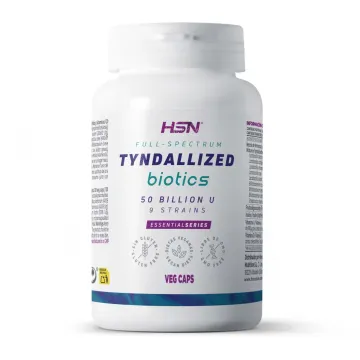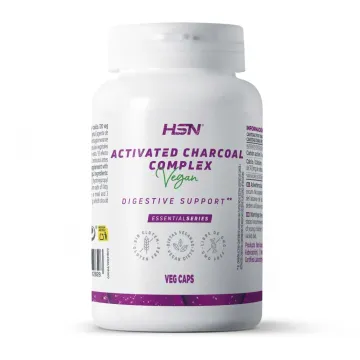- Gzymes (Enzyme blend) is an exclusive HSN formula - You won't find it in other brands.
- Specific enzyme blend: Papain, Prolyl-oligopeptidase, Protease, and Bromelain.
- High concentration and enzymatic activity**.
- With calcium carbonate - Calcium is a mineral that contributes to the normal functioning of digestive enzymes.
- Formula with Tolerase® G as the main raw material - A DSM innovation (Netherlands).
Gzymes (Enzyme blend) will become your greatest ally
Gzymes (Enzyme blend) by EssentialSeries is a food supplement in vegetable capsules, made with a specific blend of enzymes designed for digestion, and calcium.
HSN’s unique Gzymes (Enzyme blend) combination consists of calcium carbonate, for its properties that contribute to the normal functioning of digestive enzymes; and Prolyl-oligopeptidase, Papain, Bromelain, and Protease.
Try this combination of 4 highly concentrated enzymes!
Gzymes (Enzyme blend) formula - We tell you everything!
How did the idea come about?
At HSN, we research and have specialised teams studying market needs. Our products serve a clear purpose aimed at improving quality of life, so you won't find formulas without a clear objective in our catalogue. Our formulations are tailored to the population's needs, avoiding commercial developments that may seem appealing but lack depth.
Gzymes (Enzyme blend) is specifically designed using enzymes for digestion, including a patented Prolyl-oligopeptidase, registered by DSM as Tolerase® G.
Discover Gzymes (Enzyme blend)!
Selection of enzymes to use
The enzymes used in the Gzymes (Enzyme blend) formula were chosen for the synergy they can create together.
The composition of Gzymes (Enzyme blend) provides:
- Papain.
- Prolyl-oligopeptidase.
- Protease.
- Bromelain.
All of them present in optimal concentrations, which combined with their enzymatic activity**, they make the Gzymes (Enzyme blend) formula a complete and high-quality supplement you won’t want to miss.
Why calcium in the composition?
You might wonder why calcium is added to a product that combines digestive enzymes. Why?
All our products are formulated with ingredients added for well-founded reasons, not for mysticism. The calcium in the Gzymes (Enzyme blend) formula is included because it contributes to the normal functioning of digestive enzymes.
Tolerase® G, discover an innovative patent
Tolerase® G is the registered trademark used by DSM for its patented development process of the enzyme endopeptidase: Prolyl-oligopeptidase.
This patent is internationally recognised, not only for the reputation and positive evaluations of the company behind it but also for the studies supporting it (see References section), due to its unique and specific structure.
Some of the key aspects of DSM’s patented enzyme include:
- Prolyl-oligopeptidase is an enzyme preparation with activity exceeding 580,000 PPI/g (1).
- Thanks to its chemical composition, 'Prolyl-oligopeptidase' is a peptidase enzyme capable of hydrolysing proline bonds (prolyl). Gluten is a prolamin, a protein naturally rich in proline (2).
- Tolerase® G is stable and active in the acidic conditions of the stomach.
- It is resistant to digestion by pepsin.
- It is not synthetic - This enzyme is developed from food-grade Aspergillus niger.
High concentration and enzymatic activity** - How to recognise them
Enzymes have different values to consider compared to other compounds that are typically measured by mass. For example, a compound like creatine has a key value to know: the amount used; with this information, you understand its effects. However, enzymes work differently:
With digestive enzymes, it's not just the quantity used that’s important (although it is), but also their activity**. The enzymatic capacity of each one is a crucial factor. We have considered this, not only in the research associating a certain amount of enzymatic activity** with a positive effect, but also in the selection of the highest certified concentration raw materials.
Our Gzymes (Enzyme blend) features the following nutritional composition:
| Enzyme | Concentration | Activity** / dose |
| Papain | 6000 USP/mg | 300000 U |
| Prolyl-oligopeptidase | 580000 PPI/g | 87000 U |
| Protease | 450000 HUT/g | 25500 U |
| Bromelain | 2500 GDU/g | 250 U |
The meaning of the abbreviations associated with concentration represents the units of activity** based on the substrate measured:
- UPS: Units as per the United States Pharmacopeia standards.
- PPI: One PPI is defined as the amount of enzyme required to release one picomole of pNA from Z-Gly-Pro-pNA in 1 second under assay conditions.
- HUT: Hemoglobin units on a tyrosine basis (a proteolytic measure).
- GDU: Gelatin digestion units (another proteolytic measure).
More products in this category you may be interested in
At HSN, we have multiple products designed for various gut-related functions.
You can find our probiotics, other enzyme products like lactase, fibres such as psyllium husk or glucomannan, and more.
Find all products in our 'Digestion' category.
Bibliographic references
- (1) Specifications of Prolyl-oligopeptidase enzyme preparation, Annex I, COMMISSION IMPLEMENTING DECISION (EU) 2017/1387 of 24 July 2017
authorising the placing on the market of an enzyme preparation of prolyl oligopeptidase produced with a genetically modified strain of Aspergillus niger as a novel food ingredient under Regulation (EC) No 258/97 of the European Parliament and of the Council. - (2) Safety of Prolyl-oligopeptidase as a novel food pursuant to Regulation (EC) No 258/97 Safety of proline‐specific oligopeptidase as a novel food pursuant to Regulation (EC) No 258/97 (wiley.com).
- SCIENTIFIC OPINION: Scientific Opinion on the substantiation of health claims related to calcium and maintenance of bones and teeth (ID 224, 230, 231, 354, 3099), musclefunction and neurotransmission (ID 226, 227, 230, 235), blood coagulation(ID 230, 236), energy-yielding metabolism (ID 234), function of digestive enzymes (ID 355), and maintenance of normal blood pressure (ID 225, 385,1419) pursuant to Article 13(1) of Regulation (EC) No 1924/2006 https://efsa.onlinelibrary.wiley.com/doi/epdf/10.2903/j.efsa.2009.1210
- Salden, B. N., Monserrat, V., Troost, F. J., Bruins, M. J., Edens, L., Bartholomé, R., … Masclee, A. A. (2015). Randomised clinical study: Aspergillus niger-derived enzyme digests gluten in the stomach of healthy volunteers. Alimentary Pharmacology and Therapeutics, 42(3), 273–285.
- Tanner, G. J. (2021). Relative Rates of Gluten Digestion by Nine Commercial Dietary Digestive Supplements. Frontiers in Nutrition, 8, 784850.
- Dunaevsky, Y. E., Tereshchenkova, V. F., Belozersky, M. A., Filippova, I. Y., Oppert, B., & Elpidina, E. N. (2021). Review effective degradation of gluten and its fragments by gluten-specific peptidases: A review on application for the treatment of patients with gluten sensitivity. Pharmaceutics, 13(10).
- Stepniak, D., Spaenij-Dekking, L., Mitea, C., Moester, M., De Ru, A., Baak-Pablo, R., … Koning, F. (2006). Highly efficient gluten degradation with a newly identified prolyl endoprotease: Implications for celiac disease. American Journal of Physiology - Gastrointestinal and Liver Physiology, 291(4), G621-9.
- Yoosuf, S., & Makharia, G. K. (2019). Evolving therapy for celiac disease. Frontiers in Pediatrics, 7(MAY), 193.
- Mitea, C., Havenaar, R., Wouter Drijfhout, J., Edens, L., Dekking, L., Koning, F., & Dekking, E. H. A. (2008). Efficient degradation of gluten by a prolyl endoprotease in a gastrointestinal model: Implications for coeliac disease. Gut, 57(1), 25–32.
- The Efficacy of Plant Enzymes Bromelain and Papain as a Tool for Reducing Gluten Immunogenicity from Wheat Bran.
- Combination of Gluten-Digesting Enzymes Improved Symptoms of Non-Celiac Gluten Sensitivity: A Randomized Single-blind, Placebo-controlled Crossover Study.
** Prolyl-oligopeptidase 580,000 PPI/g | Bromelain 2500 GDU/g | Protease 450,000 HUT/g | Papain 6000 USP/mg.
 Before
Before After
After During
During Morning
Morning Afternoon
Afternoon Night
Night
 Delivery in 3-5 working days
Delivery in 3-5 working days






